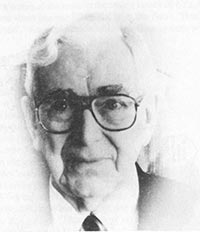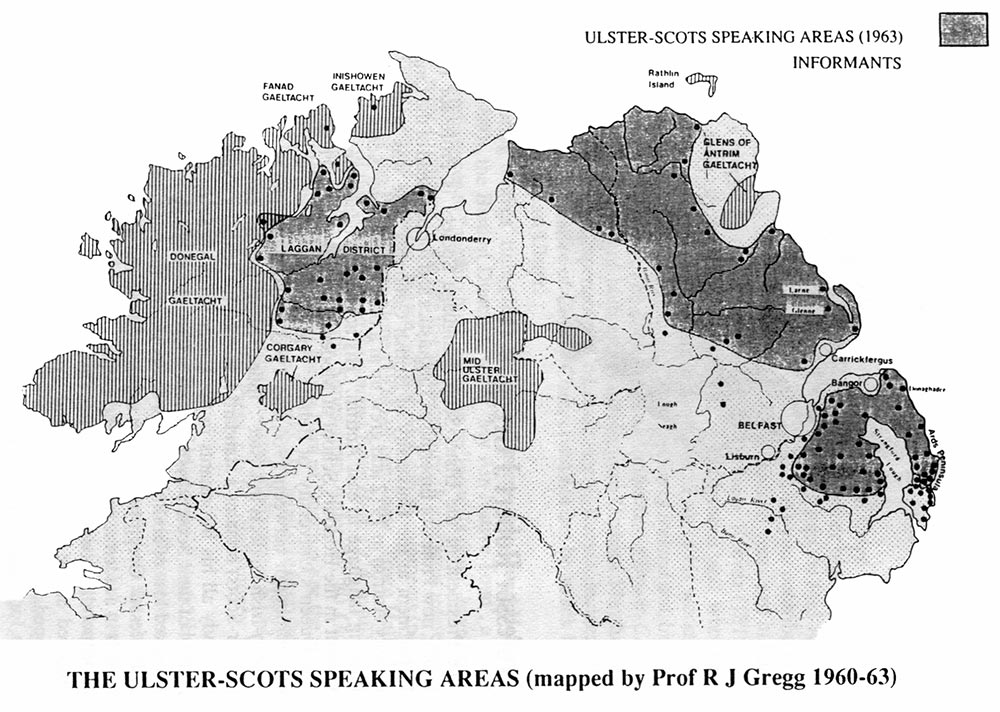Professor Robert J Gregg
Author: Robert J Gregg
Date: 1994
Source: Ullans: The Magazine for Ulster-Scots, Nummer 2 Spring 1994

The President of the Ulster-Scots Language Society is Professor Robert J Gregg, now Professor Emeritus of Linguistics and former Head of the Linguistics Department at the University of British Columbia. He was born in Larne, County Antrim in 1912 and grew up at a time when Ulster-Scots was a living, thriving language in east Antrim. His academic education was begun as a student in the Honours School of Modern Languages (French and German) at The Queen’s University of Belfast. For his doctoral degree at the University of Edinburgh between 1960 and 1963 he studied “The Boundaries of the Scotch-Irish Dialects in Ulster”. Indeed his map of the extent of ‘Scotch-Irish’ (Ulster-Scots) remains a standard reference for scholars today. At the time of his study all his informants in the Ulster-Scots speaking areas, had ‘perfect control of their Scotch-Irish dialects’. Even 30 years ago, however, there was a marked loss of ability in Ulster-Scots among the younger generations.
Professor Gregg has written extensively on the phonology of Ulster-Scots speech in academic journals, and continues to maintain an active interest (as a corresponding consultant) to the Concise Ulster Dictionary which is being prepared at the Ulster Folk and Transport Museum. Many years ago he developed, along with the late Brendan Adams of the Museum, a new spelling system for Ulster-Scots, which (they both hoped) would convey the sounds and pronunciations of our language more accurately than ‘English’ orthography.
Professor Gregg is a most enthusiastic supporter of the work of our Society. He has sent a number of local poems and recitations from east Antrim — which he has transcribed using his revised spelling system for Ulster-Scots. It is our intention to publish a series of these in forthcoming issues of ULLANS, and we commence with three short pieces: ‘The Kallin o the Soo’; ‘Haaleve Nicht’; and ‘Thrawen oul Jone’. An explanation of his spelling system will follow in due course.

The Källin o the Soo
TRue Byoo wuz cummin fae Raloo
The näkht he källt McCaamont’s soo.
He hut her fair between the een —
The cleanest clout ye ävver seen.
Whun doon she went withoot a squeal
The oul colie dug wuz at her heel.
He turrned aboot an laut a yell
an än the gate he run lik hell.
McCaamont heerd the noise an fuss,
Lukkt ower the waw an seen the bus.
Then oot he cum tae hae a squaat.
Says he: “Boy! Whut made ye dae thaat?
TRue Byoo says: “Maan, can ye no see?
Yer päg run oot in frunt o me.”
Fur on ma brake an clutch Aa stuid
But thaat aw prooved tae be nae guid.”
Then the poaliss cum up fae oot the toon
An they mäzhured the road baith up an doon.
Yän poalissman tae the ither saes:
“Nae maer on this road-side she’ll graze.”
The owner’s sän — Aa heerd a whäd —
allooed the soo wuz wurrth fäfteen quäd.
But his brither says: “Ye’r maakin fun,
that soo wuz weel wurrth thurrty pun!”
Then the soo wuz tukk tae the abatwaur
An buttshers cum fae the Lord knows whaur.
Each hopin there in his greedy sowl
Tae buy the päg chaep that wuz noo staen-coul.
Weel! the buttsher at baukht the soo, they say,
He wuNNered whut he’d beTTer dae,
Fur the clout she got, the soo t’would spoil.
“Whut diznae dae tae fry” says he, t’wull mebby dae tae boil.”
So, he made some intae sausage meat:
Her heid, her lugs, an aw her feet.
Whut wudnae sell as saussage meat,
he sore he’d caw it veal.
Aa’ll tell ye hoo he ended up — he only loast
THE SQUEAL!
Thomas Hugh Robinson, Larne
(Ed. R. J. Gregg)
Haaleve
Haaleve cums but yänst a year
The oul foaks yooce tae say.
So Wully aakst me tae his hooce
Tae Dränk a cup o tae.
Weel! ower Aa goes an — Boys o Dear!
We haad a wile guid time.
At the enn o the galrevitch
We could haarly see a stime.
On Haaleve Näkht.
The table — sure it nyaerly groaned
Wae ävrythin ye’d name.
If wuznae usyans’ blame!
The table claeth wuz then rouled up
Tae let the fun begän.
Aa hope the TRäcks the yungsTers played
Wud no be cawed a sän.
Thaun Haaleve Näkht.
“Gawney!” says Wul, hwaw could thaat be
At’s duNNerin on the duir?
It maan be aw the neybour’s waens
Up tae their TRäcks Aa’m sure.
Juist then we aw begun tae sneeze
No yän o uz could speak:
The hooce wuz fälled fae ruif tae fluir
Wae pepper an tow reek —
Thaun Haaleve Näkht.
Whunävver thäs had cleared awaw,
he bäg tub wuz braukht än,
An fur the räd-cheekt epples
Suin the dookin could begän.
Anither yan swung fae the ruif
Beside a läkhtet splät
An munny a bluidy mooth wuz gawt
Bae haanshin fur a bät
Thaun Haaleve Nakht.
A turnip peelin wuz hung up
Withoot a brek ur flaw,
An yän young laad he ett a haern —
The heid, an baens an aw.
Some wraukht at TRäcks wae a luckin gless
An ithers wae a plate.
The hael idea wuz tae fän
Hwaw’d likely be their mate,
Some Haaleve Nakht.
But naethin bae the burrnin näts
An hoo they bleezed thegither.
It wuznae aafen, Aa wud think,
They seemed tae faancy ither.
But is the cause no at the haert?
Fur some o them hiz nane,
An some hiz baad, an some hiz guid
An wuz usyins no the same,
Thaun Haaleve näkht?
John Clifford, Raloo
(Ed. R. J. Gregg)
Thrawen oul Jone an’ his Nebby Nybour
N.N.: Thaat’s a graan’ moarnin, Jone.
Jone: Weel, ye hae yer share o’t!
N.N.: Did ye git aw thon rain yäsTeday, Jone?
Jone: Aa got whut fell on me.
N.N.: Irr ye taakin thon wee coo tae the fair, Jone?
Jone: Aa’m shoor she’s no fur taakin me!
N.N.: Irr ye fur sellin ’er Jone?
Jone: Aa’m shoor Aa’m no fur bestowin ’er.
N.N.: Is thaat yer sän ye hae wae ye, Jone?
Jone: Weel, Aa raired ’im onnywey.
N.N.: Ye’r gey an’ shoart the day, Jone.
Jone: Aa’m jist as laang as ävver Aa wuz!
N.N.: Arr ye awaw, Jone?
Jone: Aa’m nether a waw nur a stane dyke!
NOTE:
This duologue is part of Glenoe’s oral tradition. I have never seen it nor heard of it in print. It was often quoted by people from the area. When, at the end of a visit, someone rose to leave the host might say “Arr ye awaw, X?” and X would reply: “Aa’m nether a waw nur a stane dyke,” evoking laughter. In our family, growing up in Larne, we heard it so often from my mother that we knew it all by heart.
Back in the fifties, while waiting in a Belfast bus depot I was chatting with a man from the Laggan district in Donegal. I was naturally interested in his dialect, and found to my surprise that he was familiar with the above duologue. He had only one variant. His reply to: “Ye’r gey an’ shoart …” had the word “e’er” (pronounced like air, and not “ävver”.
(Ed. R. J. Gregg)
Next: Animals and Insects
Previous: Letter Fae Bellamena
Contents: Ullans: The Magazine for Ulster-Scots, Nummer 2 Spring 1994

